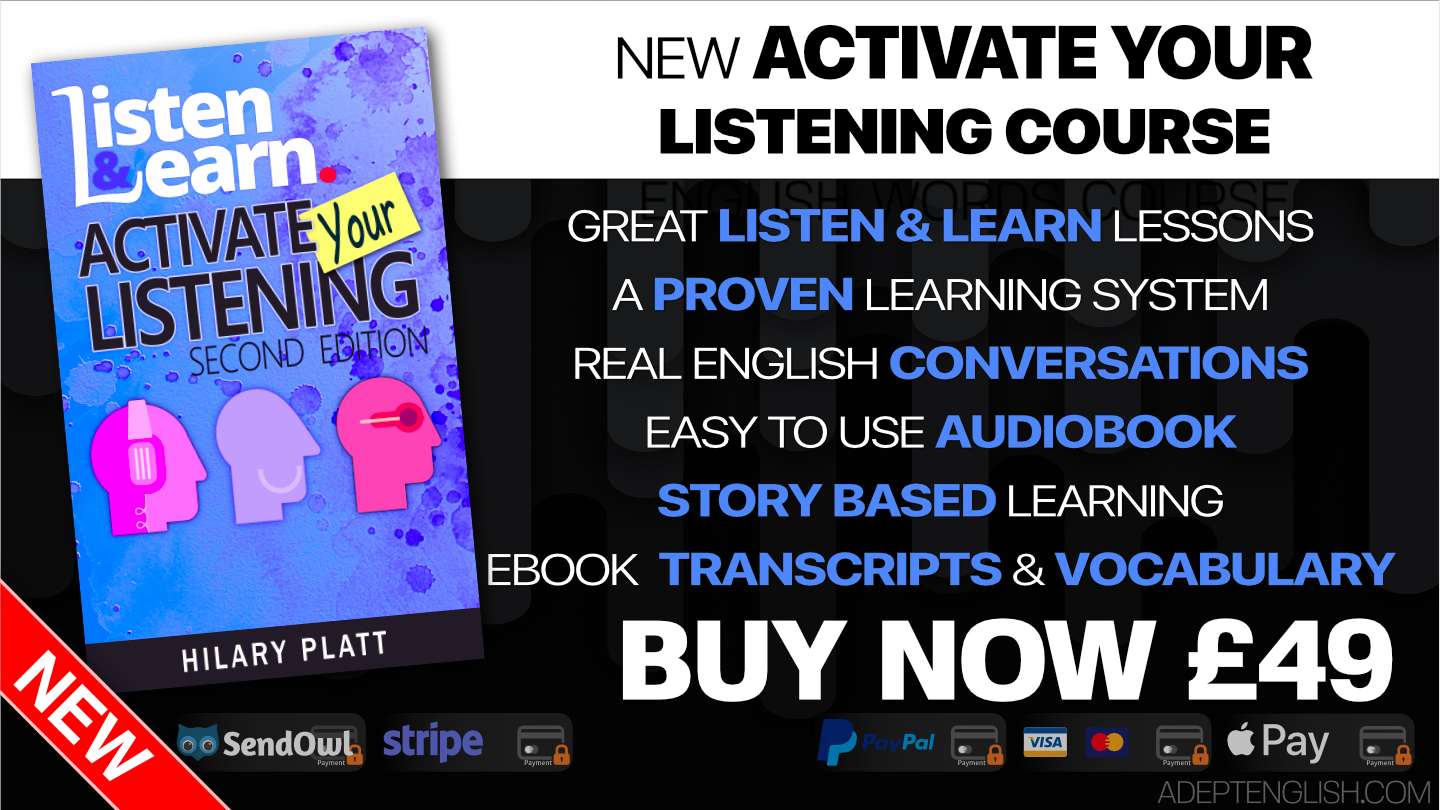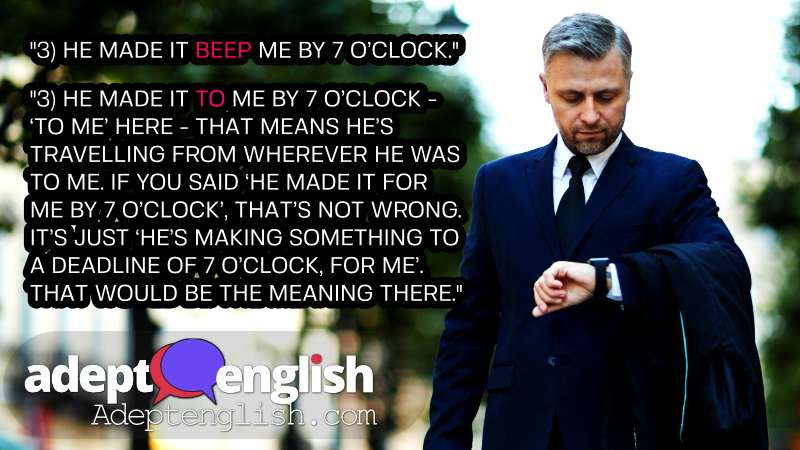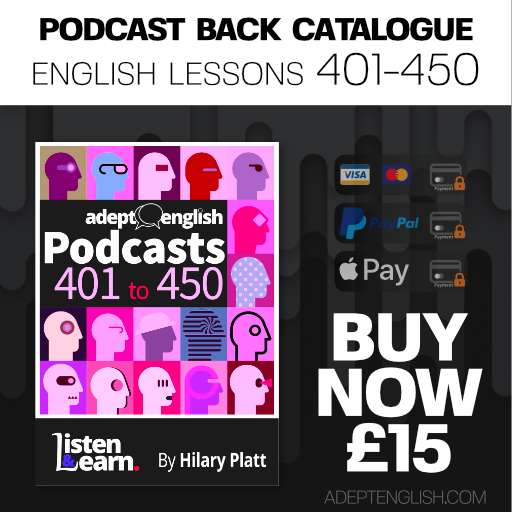Learn How To Use TO And FOR Properly And Avoid Common Grammar Mistakes
Today we will make sure you use TO and FOR correctly in your English. So, if you are looking to avoid mistakes that make you sound like an English language learner or you are looking for high scores in your IELTS exams both written and spoken, this is the podcast English lesson for you!
There are over 100 prepositions in English. If you are a regular listener to Adept English, you already know that we try to learn English efficiently. Rather than learn a list of 100 prepositions, we will focus on the most commonly used prepositions. That means you spend your precious time focused on learning and practicing with the top 2, 5 or 10 words, idioms and phrases, the vocabulary you will definitely need.
Today, that means we will focus on 2 simple prepositions which are used ALL the time. Prepositions that people who speak English as a second language (ESL) can find difficult to understand and use correctly. After listening to this ESL English grammar podcast, you will know how to use the prepositions TO and FOR correctly.
What is a preposition? Well, a preposition is a typically a word that shows a relationship between two or more people, things or places. Most prepositions are single words, however they can be pairs or even groups of words.
Even if you think you’ve got a great understanding of using TO and FOR prepositions, I recommend you listen to the podcast lesson. There are a few questions towards the end of the lesson so you can test yourself and prove you’ve got these tricky prepositions under control.
Most Unusual Words:
Relationship
Prepositions
Tricky
Procrastination
Duration
Determines
Behalf
Most common 2 word phrases:
| Phrase | Count |
|---|---|
| To Manchester | 3 |
| To Another | 3 |
| Little Words | 3 |
| To Buy | 3 |
| To Go | 3 |
| From One | 3 |
| Talking About | 2 |
| You Can | 2 |
| You Might | 2 |
| To Exercise | 2 |
| To Fry | 2 |
| English Language | 2 |
| Three Hours | 2 |
Listen To The Audio Lesson Now
The mp3 audio and pdf transcript for this lesson is now part of the Adept English back catalogue . You can still download and listen to this lesson as part of one of our podcast bundles.Transcript: How To Use TO And FOR Correctly And Improve Your ESL English Grammar
Do you have problems knowing when to use ‘to’ and when to use ‘for’ in English? It’s often with these really simple little words that English language learners have difficulties. So how about today we talk when you use ‘to’ and when you use ‘for’ - and then we’ll do a test, a quiz at the end so you can check how you do, what you’ve learned? And thankyou to our listener Juglen in the Netherlands for suggesting this one. Hope I’ve pronounced your name correctly.
Hello, I’m Hilary, and you’re listening to Adept English. We will help you to speak English fluently. All you have to do is listen. So start listening now and find out how it works.
‘To’ and ‘for’ are prepositions - the trick is how to use them
So these little words are prepositions - ‘to’ and ‘for’. Little words that go in front of nouns that you learn right at the start of your English language learning. But don’t be misled by the shortness of these words - it doesn’t mean that using them correctly is easy. Native speakers will hear your mistake with these kinds of words, but they probably won’t tell you because they’ll understand what you mean. But you want to get it right, don’t you? Let’s have a look at the differences ‘to’ and ‘for’ - and let’s have a look at where either would be correct, but where they have a different meaning.
Video
How to use the preposition ‘to’
So first of all ‘to’.
Well ‘to’ always appears with the infinitive part of the verb. By that, I mean ‘to go’, ‘to buy’, ‘to sail’, ‘to sing’. It’s not really a preposition here - but it is a place that we always use ‘to’. ‘She decided to have lessons in ballroom dancing’ - ‘to have’. Or ‘He made a new year’s resolution to exercise more often’ - ‘to exercise’. ‘I have to go to a meeting next week’ - ‘to go’. So all of those are infinitives and they always have ‘to’.
We also use ‘to’ to show a purpose, a reason for something. ‘I’m going to town to buy some shoes’. ‘I’m heating up some oil to fry my eggs’. So notice this always goes with a verb. ‘To buy’, ‘to fry’.
We also use ‘to’ when we’re talking about movement, from one place to another. So ‘I’m driving from Oxford to Manchester tomorrow’. ‘Do you want to come to my house tomorrow?’ Or we also use it when something changes from one thing to another. if it’s a change happening, you might say ‘The traffic lights changed from green to red’.
You might also use ‘to’ when you’re talking about distance. How far is it to Manchester? ‘Oh, it’s two hundred miles from here to Manchester’.
And not just physical distance - you can also use ‘to’ to show distance in time. ‘The supermarket is open from today 9am to 7pm’. ‘It’s three hours to the start of the show’. That means from now until the start of the show is three hours. So we use ‘to’ when you saying from one time to another time, ‘from 9am to 7pm’ - or from now until a time in the future, ‘It’s three hours to the start of the show’.
Often you use ‘to’ with limits. In Monday’s podcast, I talked about procrastination and deadlines. So you might say ‘It’s four days now to the deadline’. Or you might say ‘She went to the edge of the football pitch - ‘to the edge’. Or you might say ‘I watched the film to the end’. So, limits and deadlines.
OK - so those are some of the main ways in which we use ‘to’.I can’t do all of them, but let’s deal with the most common ones. Do you want a recap?
Recap on how to use the preposition ‘to’
Well, first ‘to’ is used with the infinitive - ‘I want to sit down’ - ‘to sit’. ‘I like to eat fish’ - ‘to eat’.
We use ‘to’ to show purpose - ‘I cleaned the floor to show I wanted to help’. ‘I went to the shop to buy eggs’.
We use ‘to’ for physical distance - I travelled to Manchester - and also distance in time - ‘It’s five days to the start of our holiday’. Or ‘to’ can be used to talk about a limit, an endpoint ‘We travelled to the border with Scotland’.
What about ‘for’?
How to use the preposition ‘for’
Well, we can use ‘for’ to show effect on something. ‘Eating salad is good for your health’. ‘Eating sugar is bad for your teeth’.
And we use ‘for’ to show a duration of time, a period of time - in a slightly different way to how we use ‘to’ for time. I might say ‘I’ve been doing Adept English for five years now’. Or ‘I waited for twenty minutes while my neighbour was trying to start her car’. You can also use it in the future ‘I will exercise for an hour today’. So, yes you can talk about time with both ‘to’ and ‘for’ - and it just takes practice to get it right. So - the important difference - if you’re talking about a number of minutes or hours, it’s usually for - ‘for five hours’. If you’re naming specific points in time, or a range if times it’s ‘to’. ‘From 7am to 9pm’.
We also use ‘for’ to show purpose - ‘That pan is for frying eggs’ ‘I’ve got out that jacket and scarf for my walk.’ So hang on a minute - more overlap! Isn’t ‘to’ used also to show purpose? Well, yes it is, but slightly differently. Here are some sentences to help you tell the difference.
‘I use that pan to fry my eggs’ - so that’s ‘to’. ‘I use that pan for eggs’. ‘I use that pan for frying eggs’.
So the first one ‘I use that pan to fry eggs’ - if you’re showing purpose with ‘to’, ‘to’ needs to be followed by a verb. But if you express purpose with a noun, you’ll need ‘for’ - ‘I use that pan for eggs’ But in English you can also make verbs into a noun. So we take a verb like ‘to fry’ and we make a noun out of it - ‘frying’. ‘The frying of the eggs took 2 minutes’. So in that last example ‘I use that pan for frying eggs’ - this one is a ‘for’ because the word ‘frying’ is a noun, or it’s actually called a gerund but it’s a part of a verb that behaves more like a noun.
So hang in there with me - these ones are important! Those sentences again:- ‘I use that pan to fry my eggs’ or ‘I use that pan for eggs’. ‘I use that pan for frying eggs’. So generally ‘to’ with a verb and ‘for’ with a noun. Even if you just remember that, this podcast will have really helped you!
But one of the main uses of ‘for’ is when we are acting ‘on someone else’s behalf’ - we’re doing something to help the other person. ‘I’m going to raise money for homeless kittens’. ‘I’m going to do the cooking for my mum’. ‘I’ve got my mum in mind and I’m doing it for her’.
So what about a little recap on ‘for’?
Recap on how to use the preposition ‘for’
So, we use it to talk about about effect. ‘Eating vegetables is good for you’. We use it if we’re talking about a duration of time ‘for three hours’, ‘for five days’, ‘for twenty minutes’. We use it to show purpose - but remember if it’s a straight verb, it’s ‘to’, but if it’s a noun or a gerund, it’s ‘for’.
And we use ‘for’ when we’re helping out, acting on behalf of the other person, doing something for them. ‘I’ve made a cup of tea for you’. ‘I’ve done the washing up for you’.
Sentences where ‘to’ or ‘for’ changes meaning
OK, so what about some sentences, where you can use either, but where it changes the meaning, depending upon which one you use?
Download The Podcast Audio & Transcript
‘I took a present to my son’ - that means I took a gift to where my son was, and I gave it to him. But if I say ‘I took a present for my son’ - that would mean that I took a present on his behalf, to give to someone else from my son’. Perhaps it was for his teacher. Another one of those?
‘I made a phone call to my daughter’ - that means I called my daughter on the phone and I had a conversation with her. But if I say ‘I made a phone call for my daughter’ - that means that I called someone else for her, on her behalf. Maybe she didn’t want to make the call herself. Maybe I had to phone her work to tell them she was sick, perhaps. The point is, whether you use ‘to’ or ‘for’ here determines the meaning - who’s talking on the phone to whom? So it’s quite important!
A reminder of Course One Activate Your Listening
Shall we have a little quiz, so that you can test yourself, see how you’re doing with this, whether you can get it right? Just before we do that, a reminder that if you would like to learn common vocabulary in English and you’d like practice at understanding English conversation, then you can buy our ‘Course One, Activate Your Listening at adeptenglish.com.
Boost Your Learning With Adept English
A quiz on using ‘to’ and ‘for’
Here goes with the quiz. When you hear this noise BEEP, you have to say whether it’s ‘to’ or ‘for’.
- He gave that present BEEP me BEEP my birthday
- She made the cake BEEP me on my birthday.
- He made it BEEP me by 7 o’clock.
- It was really difficult BEEP understand the book.
- He was recognised BEEP his skill in voiceover.
- I took the train from London BEEP Edinburgh.
- I sat on my own BEEP twenty minutes.
- It’s twenty minutes BEEP the end of the film.
- I got out that pan BEEP fry my eggs.
- That pan is used BEEP frying onions.
📷
A photograph of a business man looking at his watch. Today, we will learn how to use the prepositions TO and FOR correctly and some tricks that you can use to quickly implement this knowledge into your daily English.
Answers to the quiz on ‘to’ and ‘for’
OK, how did you do at that? Shall we go through with answers quickly?
- He gave that present TO me FOR my birthday - ‘to me’ is a motion and ‘for my birthday’ expresses a purpose.
- She made the cake FOR me on my birthday - ‘for me’ here is acting on someone’s behalf, doing them a favour, showing kindness.
- He made it TO me by 7 o’clock - ‘to me’ here - that means he’s travelling from wherever he was to me. If you said ‘He made it FOR me by 7 o’clock’, that’s not wrong. It’s just ‘he’s making something to a deadline of 7 o’clock, for me’. That would be the meaning there.
- It was really difficult TO understand the book - ‘to understand’ here is an infinitive - always ‘to’ with infinitives.
- He was recognised FOR his skill in voiceover - ‘to recognise someone for something’ is a collocation - it’s a phrase that we use. Just one worth learning.
- I took the train from London TO Edinburgh - that’s movement again.
- I sat on my own FOR twenty minutes - ‘for twenty minutes’ because it’s a duration of time.
- It’s twenty minutes TO the end of the film - ‘twenty minutes to the end’ - so it’s a limit or a deadline.
- I got out that pan TO fry my eggs - ‘to fry my eggs’ - well yes, it’s an infinitive but it’s giving a purpose and it’s a verb - so it’s ‘to’.
- That pan is used FOR frying onions - ‘for frying’. So again purpose, but we’ve got that gerund again, that noun made from a verb. You could equally well say ‘That pan is used for onions’ - either way it’s ‘for’ because you’re using it with a noun.
Phew - what a lot there is to say about these tiny little words in English. But this is something that people find difficult - and it’s been quite hard work explaining it, even though we English speakers just do it automatically! It is complicated, but English speakers aren’t special! They can only do it because they’ve practised a lot. So you can do it too - you just need to practise! So listen to this podcast a number of times, until it makes sense and you can remember the different uses of ‘to’ and ‘for’.
Goodbye
Enough for now. Have a lovely day. Speak to you again soon. Goodbye.
Thank you so much for listening. Please help me tell others about this podcast by reviewing or rating it. And, please share it on social media. You can find more listening lessons and a free English course at adeptenglish.com







